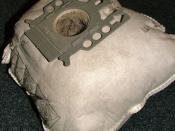The Household Vacuum Cleaner
The vacuum cleaner is a common household appliance that uses the means of a number of simple components that work together to pick up dirt and dust particles. In the typical vacuum, the components are as follow:
-Intake Port
-Exhaust Port
-Electric Motor
-Fan
-Porous Bag
The propeller like fan when operating creates a pressure drop which is also in fact a partial vacuum. The difference in air pressure, forces the air in the intake port into the cleaner where the pressure is lower, hence the suction effect.
The vacuum cleaner uses the physics of drag forces to trap dust and unwanted particles. The process of entrainment is created because of drag forces acting on the dust particles. Dust entrainment works best in fast moving air which is why a small intake port cleans better than a large one.
The dominant force at work in this process is viscous drag.
The tendency to stay aloft in the air current is directly proportional to its weight and surface area. Because dust is incredibly light, its terminal velocity is also incredibly low in result making the energy (viscous drag) to keep it airborne minimal.
A problem is encountered when the porous bag becomes clogged with too many dust particles. The airflow is stunted which allows less dust to be picked up because the drag is reduced (low speed = low drag). The solution to this problem is the bag-less vacuum.
The bag-vacuum harnesses the power of centripetal force to replace the need to filter (porous bag) dust filled air. It works similar to a centrifuge in that the system is based around many cylinders which the air is spiralled around forcing the dust to the sides to settle at a collection point.
The economic option between a conventional...



Short report of how a Vacuum Cleaner works
Very well written. Now I know how my, and other vacuum cleaners work, and this essay might even help me figure out the problems with it. Keep up the good work.
2 out of 3 people found this comment useful.